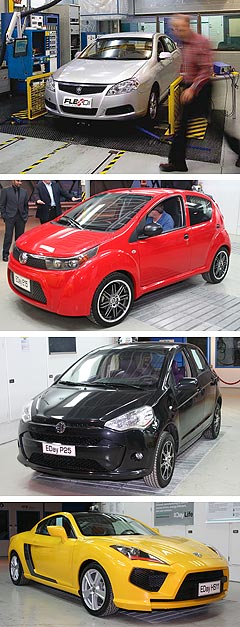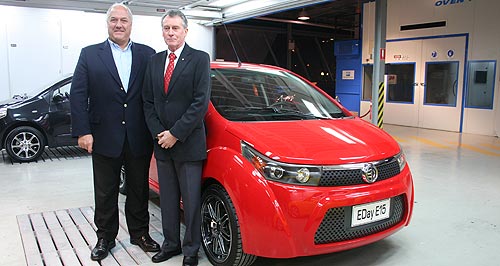Make / Model Search
Future models - EDay - E15EDay set to pioneer supercapacitor EVLocal EV angle: Robert Lane (left) and Laurie Sparke stand beside the EDay E15. Aussie EV company looks to CSIRO’s pioneering energy system for city car12 Jul 2011 FLEDGLING Australian car company EDay Life hopes to become the first electric vehicle brand to offer a mass-produced vehicle with a light, compact and powerful supercapacitor battery energy storage system developed by Australian research agency CSIRO. Melbourne-based EDay – the brainchild of former Holden Innovation director Laurie Sparke and one-time motor dealer Robert Lane – also plans to add a petrol powertrain alternative employing an advanced direct-injection fuel delivery system developed by Perth’s Orbital Corporation. While neither system will be available when the first EDay car, the electric-powered E25, is launched in a 100-car trial in Victoria early next year, EDay is already working with the CSIRO and Orbital towards the introduction of both technologies at the earliest opportunity. EDay’s vehicles are being developed by what is claimed to be China’s largest independent automotive designer and ‘original design manufacturer’ – an unnamed company that is said to have developed more than a third of current Chinese domestic vehicles. EDay showed one of its prototypes – the E15 hatchback – at the Australian International Motor Show in Melbourne this month, but it has two others, the larger E25 hatchback and HS11 hybrid sports coupe concept.  Left: Changan Orbital FlexDI test cell (source: photocall.com.au). Below: EDay E15, P25, HS11. Left: Changan Orbital FlexDI test cell (source: photocall.com.au). Below: EDay E15, P25, HS11.The E25 – which will be the first to hit the road in Australia – is based on an existing petrol-powered five-door hatchback already on the market in China, but with styling modifications specifically for EDay. Orbital is already working with China’s fourth largest motor manufacturer, Changan Automotive – a manufacturing partner with Ford, Mazda and Suzuki in the world’s biggest market – on a project to apply its patented Flex-DI air-assisted direct-injection fuel system to a four-cylinder petrol engine to meet tighter fuel consumption rules in China. The Orbital-Changan project, announced in May, is partly funded by a $440,413 grant from the Australian government’s now defunct Green Car Innovation Fund. Orbital technology is set to boomerang back to Australia in EDay’s Chinese-built range of city hatchbacks that will be offered with a choice of three powertrains – electric, petrol and dedicated LPG. “Orbital is doing brilliant stuff with their injection technology and we are waiting to pick that up as soon as it is available,” Mr Sparke said. “We start with EV and then petrol and LPG.” The first EDay cars will be powered by electric motors hooked up to lithium-ion batteries with a 160km range and top speed of 100km/h. EDay says it hopes to lease the cars at a rate that is effectively half the current price of Mitsubishi’s $48,800 i-MiEV, and offer complete refurbishment – including new batteries – after two years. “We are confident we will enter the market with a car about half the price of an i-MiEV or (Nissan) Leaf, and within a couple of years have technologies that will put us ahead of them,” he said. “As soon as we get ourselves sorted out over the next five or so years, we are going to be competing in a lot of the market.” Mr Sparke identified the CSIRO’s supercapacitor technology as one of the advances EDay hoped to introduce. Brought to market by the CSIRO’s Sydney-based commercial spinoff Cap-XX for a range of electrical devices such as cameras and mobile phones, the hybrid supercapacitors combine battery electrodes and capacitor electrodes to halve the requirement for batteries, cutting the weight of energy storage packs for cars. Ultra-thin supercapacitors are said to have 100 times the energy density of conventional capacitors. Mr Sparke said he had collaborated with the CSIRO when developing the Holden ECOommodore petrol-electric hybrid concept car that was unveiled in 2000. “The power source was a battery with supercapacitors,” he said. “To my surprise, that’s never gone any further. Battery technology has focused entirely on the battery. “The CSIRO has continued working and we have now got a partnership with them and with their industrial offshoot, called Cap-XX, who are commercial manufacturers of supercaps for phones and so on. We are now ready to move to large-size capacitors. “I hope within a couple of years we will be the first to market with the world’s first battery-supercapacitor. “The potential is to halve the size of the battery – supercaps weigh nothing. “Halving the size of the battery means you take 100-150kg mass out of the car, so you don’t need as much battery anyway so you can use the battery size again, and start saving some money.” While the ECOmmodore used supercapacitors with lead-acid batteries in a combination dubbed UltraBattery by the CSIRO, a modern electric car would use a combination of supercapacitor and lithium-ion battery. Mr Sparke said supercapacitors charge and discharge quickly, capturing the energy from vehicle deceleration to be re-used under acceleration. He said longer battery life was a benefit of the system, as the supercapacitor protected the battery from power surges, known as load levelling. “The supercap takes all the impact of the high-energy surges from braking and accelerating and extend the life of the battery – win, win, win,” he said. “Australian technology.”‘Supercaps’ are the holy grail of electric car engineers, with electric car pioneer Tesla and its giant partner Toyota said to have hopes pinned on battery-supercapacitors as the next big thing in electric vehicles. Although the technology is said to be expensive in the large-scale packs required for cars, Mr Sparke said halving the size of the lithium-ion batteries would cut costs. “Potentially it’s a $10,000 battery pack, so we can pull a few thousand dollars out and put in a decent size supercap,” he said. “It is all about volume production. Cap-XX is very confident they can develop a supercap to suit at an appropriate price for us. “A lot of car-makers now are working at stop-start systems that use super-caps to store energy from braking and use it for accelerating again without going to a full hybrid. “That’s going to drive the volumes.” Although Mr Sparke and Mr Lane have declined to name the Chinese manufacturer that has been contracted to build its range, they say the company has built a production plant from scratch on a greenfield site since they signed the deal six months ago. They say the plant will be ready to run out cars by September. Mr Lane said that if Australian sales go well, the company will introduce the E25 and E15 into other right-hand drive markets such as Hong Kong, Britain and Singapore. “We think we can drive this thing into the global market place in the next few years and stay a step ahead,” he said. Mr Sparke indicated that a freshly styled car would enter the market after the initial E25 trial, with a design owned by EDay. “Within a period of less than a year, we will have complete authority on the external appearance of the vehicle,” he said. “This car will be a unique-appearance car, for us.”  Read moreAll future models Alfa Romeo Alfa Romeo Abarth Abarth Alpine Alpine Alpina Alpina Audi Audi Aston Martin Aston Martin BMW BMW Bentley Bentley Chery Chery Brabham Brabham Chrysler Chrysler Chevrolet Chevrolet Cupra Cupra Citroen Citroen DS DS Dodge Dodge Fiat Fiat Ferrari Ferrari Foton Foton Ford Ford Great Wall Great Wall FPV FPV Haval Haval GWM GWM Honda Honda Holden Holden Hummer Hummer HSV HSV Infiniti Infiniti Hyundai Hyundai Jaguar Jaguar Isuzu Isuzu Kia Kia Jeep Jeep Land Rover Land Rover Lamborghini Lamborghini Lexus Lexus LDV LDV Mahindra Mahindra Lotus Lotus Mazda Mazda Maserati Maserati Mercedes-AMG Mercedes-AMG McLaren McLaren MG MG Mercedes-Benz Mercedes-Benz Mitsubishi Mitsubishi Mini Mini Opel Opel Nissan Nissan Peugeot Peugeot Pagani Pagani Proton Proton Porsche Porsche Renault Renault Ram Ram Rover Rover Rolls-Royce Rolls-Royce Skoda Skoda Saab Saab SsangYong SsangYong Smart Smart Suzuki Suzuki Subaru Subaru Toyota Toyota Tesla Tesla Volvo VolvoMotor industry news |
Click to shareEDay modelsAll future models Alfa Romeo Alfa Romeo Abarth Abarth Alpine Alpine Alpina Alpina Audi Audi Aston Martin Aston Martin BMW BMW Bentley Bentley Chery Chery Brabham Brabham Chrysler Chrysler Chevrolet Chevrolet Cupra Cupra Citroen Citroen DS DS Dodge Dodge Fiat Fiat Ferrari Ferrari Foton Foton Ford Ford Great Wall Great Wall FPV FPV Haval Haval GWM GWM Honda Honda Holden Holden Hummer Hummer HSV HSV Infiniti Infiniti Hyundai Hyundai Jaguar Jaguar Isuzu Isuzu Kia Kia Jeep Jeep Land Rover Land Rover Lamborghini Lamborghini Lexus Lexus LDV LDV Mahindra Mahindra Lotus Lotus Mazda Mazda Maserati Maserati Mercedes-AMG Mercedes-AMG McLaren McLaren MG MG Mercedes-Benz Mercedes-Benz Mitsubishi Mitsubishi Mini Mini Opel Opel Nissan Nissan Peugeot Peugeot Pagani Pagani Proton Proton Porsche Porsche Renault Renault Ram Ram Rover Rover Rolls-Royce Rolls-Royce Skoda Skoda Saab Saab SsangYong SsangYong Smart Smart Suzuki Suzuki Subaru Subaru Toyota Toyota Tesla Tesla Volvo VolvoMotor industry news |











Facebook Twitter Instagram